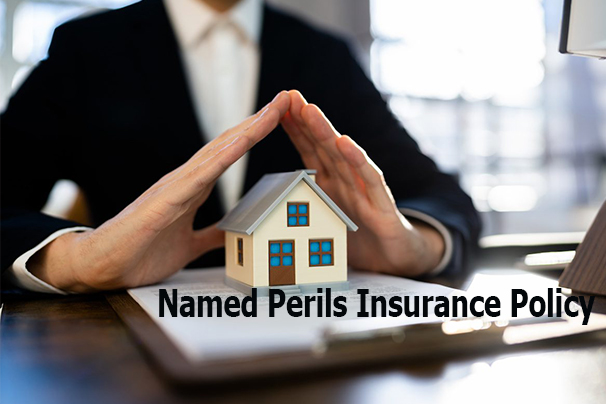When securing homeownership or business property insurance, you must determine if you want a named peril or not. Named perils include coverage for particular causes of loss or damage that are listed in the insurance policy.

Additionally, it’s an essential vitality in property insurance, particularly for properties situated in regions that experience events such as windstorms, fires, or even volcanoes. To follow the fundamentals of named perils is to ascertain if this policy aligns with the needs of your business or home.
What Named Perils Insurance Policy
A named perils insurance policy covers losses to your property from incidents or risks specifically listed in the plan. Additionally, homeowners have the option to buy this policy and choose coverage only for hazards such as theft or fire.
For homeowners residing in flood-prone areas, getting a named peril insurance policy instead of earthquake coverage is a common choice. Moreover, dangerous incidents like theft, fire, hail, earthquakes, and flooding can be included in a named perils insurance policy.
Furthermore, an all-risks policy provides coverage for all perils except those excluded from the list. However, it’s important to note that an all-risks policy doesn’t require guaranteeing coverage against all forms of peril. In addition, homeowners are to review their insurance policies to ensure they cover all the perils they are issued.
How Does It Work?
For insurance companies to cover losses under a named peril policy, the insured must demonstrate that the claim meets three specific criteria:
- The policy explicitly states coverage for the peril in question.
- The peril resulted in damage to the building or covered property.
- The loss was accidental and unforeseen.
The last one is very significant to insurers because coverage determines whether the loss could have been prevented. For instance, if a fire breakout is caused by old equipment with poor electrical wiring, your insurance provider might not cover the property damage.
This is because the fire could likely have been prevented with great care and maintenance of the office tools. However, if a brand-new electronic device were to catch fire, it would be covered, as the fire caused by new equipment is considered sudden and could not have been prevented through maintenance.
Why Purchase a Policy?
Homeowners must comprehend the named perils insurance policy as they evaluate the various forms available and determine which suits best with their circumstances. Factors such as location and financial status can significantly influence their decision.
In addition, it’s essential to comprehend the exception to the coverage, as the policyholder ensures they get adequate insurance coverage for their other properties and belongings. Lastly, the named perils policy holds significance for society and all homeowners due to the specific coverage it offers for various situations.
What Named Perils Insurance Policy Can Cover?
Not every business property policy will provide coverage for the same named perils. However, each business should conduct a risk evaluation to identify which perils are most likely to impact their operations.
Although policies vary, some common perils include:
- Fire
- Damage from aircraft and vehicles
- Lightning strikes
- Explosions
- Incidents related to strikes, riots, or civil commotion
- Windstorms (excluding hurricanes) and hail
- Vandalism or malicious acts
- Earth movement, including earthquakes and volcanic eruptions
- Damage from falling objects
- Effects of ice, sleet, and snow
- Water overflow from plumbing or HVAC systems
- Freezing of plumbing, heating, air conditioning, and household appliances
- Electrical short circuits or malfunctions
- Theft
- Smoke-related damage
In addition, a named peril policy will only cover specific hazards or perils that are listed. However, if a loss occurs due to any unnamed peril, you may be responsible for covering the resulting damages and repairs out of pocket.
What Does the Named Perils Insurance Policy Not Cover?
Named perils insurance policies have limitations and do not cover certain events, particularly those that could have been prevented. For instance, while most insurance policies cover water damage from broken pipes or overflow, they exclude coverage for floods and other natural disasters.
Moreover, coverage varies by state. For instance, losses or damages caused by earthquakes in California are typically not covered by standard renters or homeowners insurance policies. However, individuals need to review their policies for exclusions carefully and, if necessary, get extra coverage to safeguard their belongings against the risks associated with natural events.
Named Perils and Open Perils
A named-peril policy and an open peril policy represent two opposing approaches to insurance coverage. In a named perils policy, coverage extends solely to the risks listed in the policy. An open peril policy offers coverage for all risks unless specifically excluded. You will be required to decide between a named peril policy and an open peril policy for your job.
However, assessing your business and property is crucial to determine which option best aligns with your needs and situation. Typically, a named peril policy is more affordable than an open peril policy but offers less comprehensive protection. Open peril coverage provides broader protection and safeguards against unforeseen losses.
It’s important to note that even with an open peril policy, you may not be fully protected against all types of losses, as common exclusions often apply. Lastly, if the open perils policy doesn’t properly cover all the hazards, you should tend to secure a named perils policy, which can help fill any gaps in coverage.
Conclusion
Named-perils insurance policies offer protection exclusively for perils listed in the policy. Typically, it’s the most affordable option; they provide narrow coverage. However, for most homeowners, significant coverage is essential, surpassing what a named peril policy can offer.
